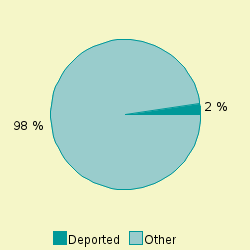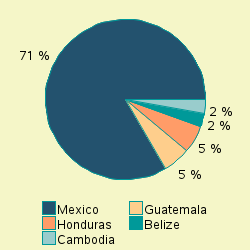Detainees Leaving ICE Detention from the
Las Vegas Hold Room
Las Vegas, Nevada
Detainees Deported or Released Number last 12 months 42 Out of total detained 477 Facility ranking on detainees top 72 %
Table 1: Number leaving ICE detention
from this facilityDuring the most recent 12 month period for which data are available, a total of 42 detainees housed at the Las Vegas Hold Room left that facility because they were deported, were released under supervision while their cases were being decided, or left ICE detention for one of a variety of other reasons. This is a special ICE holding area or staging location that under current ICE detention standards is allowed to temporarily house aliens for up to 12 or 16 hours. These types of units generally have no sleeping quarters or shower facilities.
Those individuals who departed from this facility because they were leaving ICE detention made up 9 percent of the 477 detainees housed at this facility during the last 12 months. This report focuses on the reasons these individuals left ICE detention. Sometimes this report speaks of these individuals as those "exiting" ICE detention, or simply as "exits." The others remained in ICE detention but were transferred from the Las Vegas Hold Room to other facilities.
This report covers those who left ICE custody. It excludes individuals transferred to other ICE facilities. For more information on this facility, including individuals that were transferred, see additional TRAC reports in this series.
This report series is based upon analyses conducted by the Transactional Records Access Clearinghouse (TRAC) at Syracuse University of 1.7 million government records tracking each individual who passed through an ICE detention facility during fiscal year 2015. This most recent 12 month period for which comprehensive data are available covers October 2014 through September 2015. See About the Data.
How This Facility Ranks Nationally
Rankings on the number leaving ICE detention. The Las Vegas Hold Room was one of 637 facilities nationwide that housed ICE detainees during the most recent 12 month period. Of these 637, there were 358 that had at least 10 individuals who were deported or released. Excluding those facilities with fewer than 10 exits, the Las Vegas Hold Room last year ranked in the top 72 percent nationwide in the number of individuals leaving ICE detention. This means that 72 percent of the locations contributed the same or a larger numbers of exits, while 28 percent had a smaller number. See Table 1.
Deportations. Nationally, the most common reason that a detainee left ICE detention was that they were deported from the United States. During the most recent 12 month period for which comprehensive data are available, nationwide 56.3 percent of those leaving ICE detention were deported or "voluntarily" departed. By way of comparison, a lower percentage of detainees (2 percent) left the country from the Las Vegas Hold Room because they were formally deported, or left under the so-called "voluntary departure" procedure.
Were Detained Individuals from the Local Area?
Information on the place of arrest was not included in the available data ICE released. However, we can examine whether the Las Vegas Hold Room was the first ICE facility in which these detainees were held. According to ICE records, for the vast majority (95 percent) of these detainees, the Las Vegas Hold Room was the first place they were sent when they were detained by ICE. The remaining 5 percent had been transferred in from another ICE detention facility.
We can also look at how quickly they arrived at this facility after they were first detained. Again, a total of 95 percent arrived at the Las Vegas Hold Room at some point during the very first day they were detained by ICE. There was considerable variability among detainees in the number of detention facilities they had been held in before they were finally deported or released from this facility. All detainees either entered and left this one facility, or had spent time at one additional ICE facility before their transfer to the Las Vegas Hold Room. These figures again are based on an analysis of the most recent 12 months for which data are available.
For the United States as a whole, last year the average number of ICE facilities detainees moved through was 1.8. Detainees at the Las Vegas Hold Room on average had stayed at somewhat fewer (1.0) ICE facilities.
Reason Left ICE Facility Profile U.S Profile Number Percent Percent Orders of Recognizance or Supervision 26 61.9 % 19.8 % Prosecutorial Discretion 7 16.6 % 1.0 % U.S. Marshal or Other Agency 4 9.5 % 4.5 % Proceedings Terminated 3 7.1 % 1.3 % Deported/Removed 1 2.3 % 55.3 % Withdrawal 1 2.3 % 0.2 % Alternative ATD custody 0 . 0.1 % Bonded out 0 . 11.0 % Died 0 . 0.0 % Escaped 0 . 0.0 % Release to ORR 0 . 0.1 % Paroled 0 . 5.2 % Voluntary departure 0 . 0.9 % Total 42 100.0 % 100.0 %
Table 3: Reasons individuals left ICE detention during the last 12 months
Why Did Detainees Leave ICE Detention?
ICE records one of 29 reasons a detainee left ICE detention. As shown in Table 3, these reasons fall into 13 general categories -- from leaving because one is deported or removed, to leaving because one escaped or the individual died while in custody.
Deportation. As mentioned earlier, while nationally the most common reason that a detainee left ICE detention was that they were deported from this country, this was not the top reason at this facility. At the Las Vegas Hold Room only one individual was deported or removed during the most recent 12 month period for which data are available. (ICE data did not distinguish between deportations and removals, and the terms are used interchangeably in this report.)
Orders. The issuance of an order to release the detainee was the most common reason why individuals were recorded as leaving ICE detention from this facility. Under an "order of recognizance" an individual is released with reporting conditions while in deportation proceedings and awaiting a final decision. A second type of order ("order of supervision") releases an individual after a final order of removal. Here an individual is released because ICE has not met the time limits the law imposes for deporting the individual. There were 26 (62 percent) who left the Las Vegas Hold Room detention for these reasons: 18 with orders of recognizance, and 8 with orders of supervision.
Prosecutorial discretion. The Department of Homeland Security sets immigration enforcement priorities and guidance on the exercise of prosecutorial discretion (PD), including special programs on deferred action for childhood arrivals. To focus its limited resources on higher priority targets, individuals that don't fall into these high priority categories may -- through the exercise of prosecutorial discretion -- be released from custody and any proposed deportation actions deferred. A total of 7 individuals (17 percent) were released under these PD programs.
Transferred to criminal custody. A total of 4 individuals (10 percent) left this facility last year because they were turned over to U.S. Marshals or to some other government agency. This typically occurs because there is an outstanding criminal case against the individual, or the individual is needed as a material witness in a criminal case.
No legitimate grounds to deport. Sometimes individuals left ICE detention because they "won" their case. Typically this occurs when an Immigration Judge orders the deportation proceedings ICE has filed against them "terminated" (dismissed) and the judge's order after any appeals becomes final. Analysis of the latest 12 months of data show that a total of 3 individuals, or 7 percent were released from detention by the Las Vegas Hold Room because a determination was made that there were no grounds to deport the individuals and thus ICE had to release them from custody.
Withdraw entry request. Individuals also leave ICE detention for a variety of additional reasons. One of these is that individuals who have been detained may be allowed to "withdraw" their request to enter the country. If a person withdraws their request, this effectively means they must leave the country. A total of 1 individuals (2 percent) fell into this category. Unlike deportation where the person is legally barred for a period of years and sometimes permanently from coming back to the United States, a person who withdraws their request is not for that reason barred from re-entry into this country.
Escape and death. Nationally, there were 65 individuals who escaped ICE detention during the latest 12 month period for which data are available, and 6 individuals were recorded as having died in detention. No one was recorded by the Las Vegas Hold Room as either escaping or dying last year.
As shown in Table 3, no one was recorded as leaving the Las Vegas Hold Room during the past 12 months for the following reasons: Alternative ATD custody, Bonded Out, Release to ORR, Paroled and Voluntary Return. See "Reasons for Leaving ICE Detention" for a description of these categories.
Comparing Release Reasons Against The National Picture
In many respects release reasons for the Las Vegas Hold Room departed from the national picture. It was the case that a lower proportion left because they were deported from this facility (2 percent) than was true for the U.S. as a whole (55 percent). No one left as a voluntary departure from this facility, while this was true for 1 percent of all individuals nationally.
In addition, differences were seen for detainees released on orders of recognizance or supervision (62 versus 20 percent), PD (17 versus 1 percent), those released to the U.S. Marshal or other agency (10 versus 5 percent), persons whose proceedings were terminated (7 versus 1 percent), individuals released on bond (none versus 11 percent), and for those paroled (none versus 5 percent).
The facility's percentages fell within 3 percentage points of the national figures for all other categories.
Nationalities
Which nationalities predominate? Last year in the United States, individuals from Mexico comprised the largest number of those leaving ICE detention. Some 43.4 percent of all detainees recorded Mexico as their country of origin. The Las Vegas Hold Room had a much larger proportion of detainees from Mexico - 71 percent among their exits. Detainees from Mexico were also the largest single nationality group among those leaving detention from the facility.
In descending order, the other top nationalities after Mexico that made up those leaving ICE detention from the Las Vegas Hold Room last year were: Guatemala (5%), Honduras (5%), Belize (2%), Cambodia (2%), Cuba (2%), Czechoslovakia (2%), El Salvador (2%), Ethiopia (2%), Hungary (2%) and Syria (2%).
This compared to the United States as a whole where the other top five nationalities after Mexico were Guatemala (19%), El Salvador (15%), Honduras (12%) and Ecuador (1%).
Nationalities Ranked in Top 10 Left ICE Detention Total Deported/
Voluntary
DeparturePercent - ALL 42 1 2.3 % 1 Mexico 30 0 0.0 % 2 Guatemala 2 0 0.0 % Honduras 2 0 0.0 % 4 Belize 1 0 0.0 % Cambodia 1 0 0.0 % Cuba 1 0 0.0 % Czechoslovakia 1 1 100.0 % El Salvador 1 0 0.0 % Ethiopia 1 0 0.0 % Hungary 1 0 0.0 % Syria 1 0 0.0 %
Table 4: Numbers leaving ICE detention by nationality
during the last 12 months


